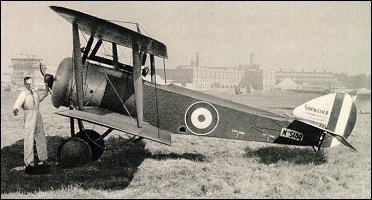|
| The Pup or Scout Tractor was Sopwith's follow-up fighter to the 1 1/2-Strutter and got its name as a smaller single-seat version. It entered service with the RNAS and RFC in the latter half of 1916, just as the Strutter was getting out of its depth in the face of the German Halberstadt and early Albatros fighters on the Western Front.
Although underpowered, the Pup was a remarkably fine aircraft with good maximum speed and climb and excellent manoeuvrability - especially when the torque of the engine was exploited for fast turns. The battles of Ypres, Messines and Cambrai kept the Pup locked in combat and helped to establish its reputation as a 'pilot's aircraft'. With the arrival of the S.E.5 and Camel, the Pup was downgraded and many performed home-defence duties. Some were occasionally armed with Le Prieur rockets for anti-Zeppelin patrols.
One of the best remembered exploits of the Pup was its use in determining the feasibility of landing conventionally wheeled aircraft on board aircraft carriers. On 2 August 1917 a Pup, flown by Squadron Cdr E. H. Dunning, landed on the deck of HMS Furious, so recording the first landing of an aeroplane on a moving ship. Grab straps attached to the aircraft enabled deck crew to pull it to rest. Unfortunately, when another landing was attempted on 7 August, the Pup stalled and went over the side of the carrier into the sea and Dunning was killed. Nevertheless the results were sufficiently encouraging for the experiments to continue and the Royal Navy became the first service in the world with an effective carrier force. A total of 1,770 Pups was built.
 | A three-view drawing (1278 x 952) |
| CREW | 1 |
| ENGINE | 1 x Le Rhone 96, 59kW |
| WEIGHTS |
| Take-off weight | 556 kg | 1226 lb |
| Empty weight | 357 kg | 787 lb |
| DIMENSIONS |
| Wingspan | 8.1 m | 27 ft 7 in |
| Length | 5.9 m | 19 ft 4 in |
| Height | 2.9 m | 10 ft 6 in |
| Wing area | 23.6 m2 | 254.03 sq ft |
| PERFORMANCE |
| Max. speed | 179 km/h | 111 mph |
| Ceiling | 5334 m | 17500 ft |
| Range w/max.fuel | 300 km | 186 miles |
| ARMAMENT | 1 machine-guns, 4 x 11kg bombs |
| Jock Williams, e-mail, 07.04.2009 23:29 I first flew a Sopwith Pup in 1979 at an Edmonton Airshow after "checking out" on the Avro 504. Suffice to say that the difference between the stately 504 and the nimble Pup was nothing short of amazing! At the time I was flying Mach 2 fighters for a living -but the Pup, after "chocks away" (there were no brakes) felt like it was a Mach 3 model. It sprang instantly into the air -and its roll and pitch rate were both incredible. For a few seconds I worried that I might not be able to get it down in one piece -but in short order I developed the required "feel" and fell in love.
The Pup was the single most exciting aircraft I have ever flown -up to and including the CF104. It was a rare and unforgetable experience indeed -and I got to repeat it numerous times while flying tor the Canadian Air Museum.
Jock Williams reply | | Ace, e-mail, 27.12.2008 08:23 the pup is a perfect dogfighter reply |
|
Do you have any comments?
|
| 
COMPANY
PROFILE
All the World's Rotorcraft
|







